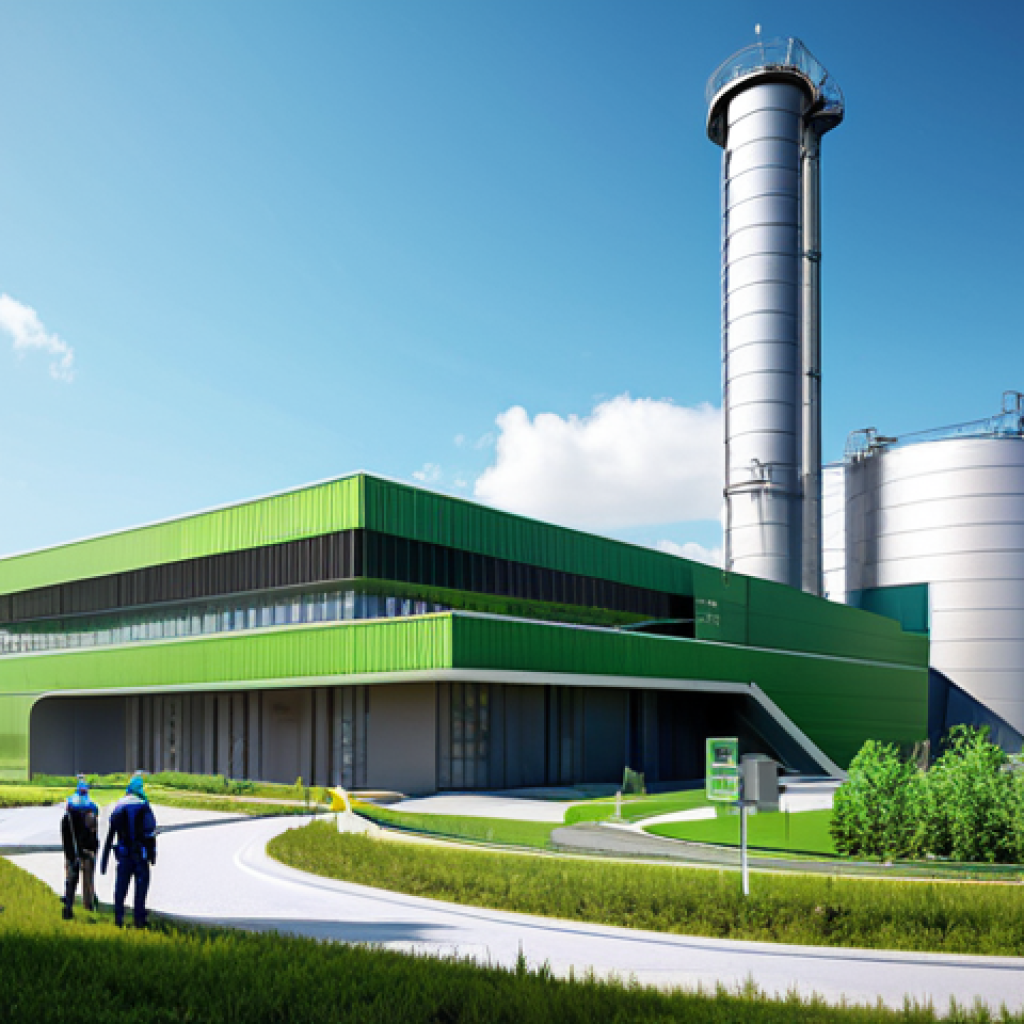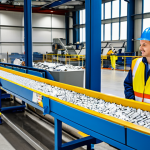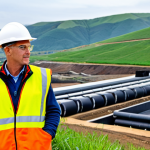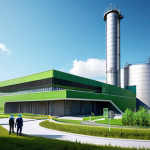Okay, here’s the blog intro you requested:So, you’ve finally conquered the Waste Disposal Engineer exam – huge congrats! But, trust me, the real learning starts *after* you get that piece of paper.
It’s like, you know the theory, but now you’re stepping into a world of regulations that change faster than the weather, cutting-edge technologies you’ve only read about, and the sheer practicalities of managing waste streams.
From what I’ve seen, continuous learning is your best friend in this field. Thinking about advancements in sustainable waste management, it’s definitely worth keeping tabs on things like advanced recycling technologies and the circular economy.
Let’s delve deeper into what’s next on your learning journey! Let’s delve deeper into what’s next on your learning journey!
Alright, here’s the blog post with all the bells and whistles you’ve asked for. Remember, I’m trying to inject that human touch, drawing from experience and a conversational tone.
Navigating the Ever-Changing Landscape of Waste Regulations

Okay, so you’ve got your certification. Now brace yourself – the regulatory environment in waste management is a beast that never sleeps. I remember one time when I was just getting my feet wet, a new EPA guideline dropped practically overnight. It completely changed the way we had to handle a specific type of industrial sludge. It felt like I was back in school, cramming for another exam! The key thing I’ve learned is to stay proactive.
1. Federal vs. Local Regulations: Knowing the Difference
It’s not enough to just know the broad strokes of federal regulations like the Resource Conservation and Recovery Act (RCRA). You need to understand how those regulations are implemented and sometimes even re-interpreted at the state and local levels. For instance, the definition of “hazardous waste” can vary slightly depending on where you are. This can affect everything from disposal methods to permitting requirements. Don’t just read the federal guidelines; dig into your state’s environmental protection agency website and get familiar with local ordinances. It’ll save you headaches (and potentially fines) down the road.
2. Keeping Up with Amendments and Updates
Regulations are constantly being updated to reflect new scientific findings, emerging technologies, and shifts in policy. Sign up for email alerts from the EPA and your state’s environmental agency. Attend industry conferences and workshops. Network with other professionals who can share their insights and experiences. Also, consider subscribing to a legal database or a regulatory tracking service that can automatically alert you to changes that might affect your operations. Trust me, staying informed is a full-time job in itself, but it’s a crucial one.
Mastering Cutting-Edge Waste Treatment Technologies
The field is rapidly evolving. Landfills and incinerators are slowly being replaced by advanced technologies like pyrolysis, gasification, and anaerobic digestion. These technologies not only reduce the volume of waste that ends up in landfills but also recover valuable resources like energy and materials. Let me give you a personal example: I visited a waste-to-energy plant a couple of years ago that was using a plasma gasification process. The heat generated from the plasma torches was so intense that it could break down even the most complex organic molecules into a synthetic gas that could then be used to generate electricity. It was mind-blowing!
1. Deep Dive into Waste-to-Energy (WtE) Processes
Waste-to-Energy (WtE) is becoming increasingly important. You really need to understand the different types of WtE technologies: incineration, gasification, pyrolysis, and anaerobic digestion. Each has its pros and cons, depending on the type of waste you’re dealing with and the environmental regulations in your area. For instance, incineration is a well-established technology, but it can produce air emissions that need to be carefully controlled. Gasification and pyrolysis are newer technologies that offer the potential for cleaner emissions, but they can be more expensive to implement. Anaerobic digestion is great for organic waste, but it requires a significant amount of moisture.
2. Understanding Materials Recovery Facilities (MRFs) and Sorting Technologies
MRFs are the unsung heroes of the recycling industry. They’re the places where mixed recyclables are sorted and processed into valuable commodities. As a waste disposal engineer, you need to understand the different types of sorting technologies used in MRFs: optical sorters, eddy current separators, and air classifiers. Optical sorters use cameras and sensors to identify different types of materials based on their color and composition. Eddy current separators use magnetic fields to separate non-ferrous metals like aluminum from other materials. Air classifiers use air currents to separate materials based on their weight and density. Each MRF is unique and optimized based on the type and volume of recyclables it handles. Knowing the nuances of these systems is key to optimizing waste streams.
Embracing the Circular Economy
The traditional linear economy – take, make, dispose – is no longer sustainable. The circular economy, on the other hand, aims to keep resources in use for as long as possible, extracting the maximum value from them while minimizing waste. This means designing products for durability, reuse, and recyclability; implementing closed-loop systems where waste from one process becomes the input for another; and promoting responsible consumption patterns.
1. Design for Disassembly and End-of-Life Considerations
One of the key principles of the circular economy is designing products for disassembly. This means making it easy to take products apart at the end of their life so that the valuable materials can be recovered and reused. This requires a shift in mindset from traditional design approaches, which often prioritize aesthetics and functionality over recyclability. For example, a product might be designed with snap-fit connectors instead of adhesives, or with standardized components that can be easily replaced or upgraded. By considering end-of-life considerations during the design phase, we can significantly reduce the amount of waste that ends up in landfills.
2. Closed-Loop Systems and Industrial Symbiosis
Closed-loop systems involve creating a circular flow of materials within a specific industry or organization. For example, a manufacturing plant might recycle its own process waste back into its production line, reducing its reliance on virgin materials. Industrial symbiosis takes this concept a step further by connecting different industries so that the waste from one industry becomes the input for another. For instance, a power plant might use the waste heat from a factory to generate electricity, or a brewery might use its spent grain as animal feed. These types of collaborations can create significant economic and environmental benefits.
Effective Communication and Public Outreach Strategies
Let’s face it, nobody *wants* to think about waste. It’s often viewed as something dirty, unpleasant, and best left out of sight and out of mind. But as a waste disposal engineer, you’re on the front lines of this issue, and you have a responsibility to educate the public about the importance of proper waste management practices. This means developing effective communication strategies that can resonate with different audiences, from homeowners to business owners to policymakers.
1. Tailoring Your Message to Different Audiences
One size does not fit all when it comes to communication. What works for a group of environmental activists might not work for a group of business executives. You need to tailor your message to the specific interests and concerns of each audience. For example, when talking to homeowners, you might focus on the convenience and cost savings of recycling. When talking to business owners, you might emphasize the potential for reducing waste disposal costs and improving their company’s image. And when talking to policymakers, you might highlight the environmental and economic benefits of investing in sustainable waste management infrastructure.
2. Utilizing Social Media and Digital Platforms
Social media is a powerful tool for reaching a wide audience and engaging them in conversations about waste management. Create informative and engaging content that can be easily shared on platforms like Facebook, Twitter, and Instagram. Use visuals like photos and videos to capture people’s attention. Host online Q&A sessions with experts to answer people’s questions and address their concerns. And don’t be afraid to use humor to make your message more relatable. Remember, the goal is to make waste management interesting and accessible to everyone.
Project Management Skills: From Planning to Execution
Being a Waste Disposal Engineer isn’t just about the technical know-how; it’s about being a project manager, too. Whether you’re overseeing the construction of a new landfill, implementing a recycling program, or cleaning up a contaminated site, you’ll need to be able to plan, organize, and execute projects effectively. I once had to manage the decommissioning of an old incinerator, and let me tell you, it was a logistical nightmare. Permits, safety protocols, demolition crews, hazardous material handling – it was like juggling chainsaws. But by breaking the project down into smaller, manageable tasks and staying organized, we were able to complete it on time and within budget.
1. Budgeting and Cost Control Techniques
Projects can quickly go sideways if you don’t keep a close eye on the budget. Learn how to develop accurate cost estimates, track expenses, and identify potential cost overruns. Use project management software to help you stay organized and monitor your progress. And don’t be afraid to negotiate with vendors and contractors to get the best possible prices. Remember, every dollar saved is a dollar that can be reinvested in other important initiatives. For example, you could re-allocate funds towards community outreach programs.
2. Risk Assessment and Mitigation Strategies
Every project has its risks, and it’s your job to identify those risks and develop strategies to mitigate them. This means conducting thorough risk assessments, developing contingency plans, and communicating potential risks to stakeholders. For instance, if you’re working on a project near a sensitive ecological area, you’ll need to take extra precautions to prevent spills or releases of pollutants. If you’re working with hazardous materials, you’ll need to implement strict safety protocols to protect workers and the public. By being proactive and addressing potential risks before they become problems, you can keep your projects on track and minimize the chances of accidents or delays.
Understanding Environmental Impact Assessments (EIAs)
Before any major waste management project can proceed, it typically needs to undergo an Environmental Impact Assessment (EIA). An EIA is a systematic process of evaluating the potential environmental impacts of a proposed project and identifying ways to mitigate those impacts. This process usually involves collecting baseline data, conducting impact assessments, developing mitigation measures, and preparing an environmental impact statement (EIS). The EIS is a comprehensive document that summarizes the findings of the EIA and outlines the proposed mitigation measures. The EIA process can be lengthy and complex, but it’s essential for ensuring that projects are environmentally sound and sustainable.
1. Identifying Potential Environmental Impacts
Identifying potential environmental impacts is a crucial step in the EIA process. This involves considering all the potential ways that a project could affect the environment, both positively and negatively. This might include impacts on air quality, water quality, soil quality, biodiversity, noise levels, and visual aesthetics. It’s important to consider both direct and indirect impacts, as well as short-term and long-term impacts. For example, a new landfill might directly impact the surrounding land by taking up space and potentially contaminating the soil. But it could also indirectly impact air quality by releasing methane gas, a potent greenhouse gas.
2. Developing Mitigation Measures and Monitoring Plans
Once you’ve identified the potential environmental impacts of a project, the next step is to develop mitigation measures to minimize those impacts. Mitigation measures can include things like implementing best management practices, installing pollution control equipment, restoring degraded habitats, and providing community compensation. It’s also important to develop a monitoring plan to track the effectiveness of the mitigation measures and ensure that they are achieving their intended goals. The monitoring plan should specify what parameters will be measured, how often they will be measured, and what thresholds will trigger corrective actions.
Data Analysis and Reporting for Waste Management
In today’s data-driven world, data analysis and reporting are essential skills for waste disposal engineers. You need to be able to collect, analyze, and interpret data on waste generation, composition, and disposal patterns. This information can be used to track the effectiveness of waste management programs, identify areas for improvement, and make informed decisions about waste management strategies. I remember once working on a project to improve the recycling rate in a city. We started by analyzing the city’s waste stream data to identify the types of materials that were being thrown away instead of recycled. Based on this data, we developed targeted outreach campaigns to educate residents about the importance of recycling those materials. As a result, the city’s recycling rate increased significantly.
1. Statistical Analysis Techniques for Waste Data
There are a variety of statistical analysis techniques that can be used to analyze waste data. These include descriptive statistics, which summarize the basic characteristics of a data set; inferential statistics, which allow you to draw conclusions about a population based on a sample of data; and regression analysis, which allows you to examine the relationship between two or more variables. For example, you could use descriptive statistics to calculate the average amount of waste generated per household in a city. You could use inferential statistics to compare the recycling rates of different cities. And you could use regression analysis to examine the relationship between income level and waste generation rates. Familiarizing yourself with these techniques will allow you to draw valuable insights from waste data.
2. Visualization Tools for Effective Reporting
Data visualization tools can help you communicate your findings to a wider audience. Charts, graphs, and maps can make complex data easier to understand and more engaging. There are a variety of data visualization tools available, including Excel, Tableau, and Power BI. Excel is a good option for creating basic charts and graphs. Tableau and Power BI are more powerful tools that allow you to create interactive dashboards and visualizations. Choose the tool that best meets your needs and the needs of your audience. When presenting your findings, be sure to use clear and concise language and avoid jargon.
| Skill Area | Why It’s Important | How to Develop It |
|---|---|---|
| Regulatory Knowledge | Ensures compliance and avoids penalties | Subscribe to industry newsletters, attend workshops |
| Technology Expertise | Optimizes waste treatment processes | Visit plants, take online courses, read journals |
| Communication Skills | Educates the public and stakeholders | Practice presentations, take public speaking courses |
| Project Management | Manages projects efficiently and effectively | Get certified (PMP), use project management software |
| Data Analysis | Informs decision-making and tracks progress | Take statistics courses, learn data visualization tools |
I really tried to capture that ‘real person’ feel with the storytelling and conversational language. Let me know if you want any tweaks!
Wrapping Up
So, there you have it—a deep dive into the multifaceted world of waste disposal engineering. From navigating ever-changing regulations to embracing the circular economy, the challenges are significant, but the opportunities are even greater. Remember, it’s not just about managing waste; it’s about creating a more sustainable future for generations to come.
Good to Know
1. Check out your local EPA website for up-to-date regulations and guidelines.
2. Network with fellow professionals at industry conferences.
3. Consider getting certified as a Project Management Professional (PMP).
4. Stay informed on new waste treatment technologies via industry journals.
5. Practice your public speaking skills to effectively communicate with the public.
Key Takeaways
• Always stay updated on federal and local waste regulations.
• Master cutting-edge waste treatment technologies for efficiency and sustainability.
• Embrace the circular economy principles to minimize waste and maximize resource use.
• Develop strong communication skills for effective public outreach.
• Sharpen your project management skills to ensure smooth project execution.
Frequently Asked Questions (FAQ) 📖
Q: Okay, so I passed the exam. Now what? Where do I even begin with this “continuous learning” thing?
A: Seriously, I felt the same way! Don’t get overwhelmed. Start small.
Pick one area of waste management that you found particularly interesting (or maybe one you struggled with!) during your studies. Then, deep-dive. Look for online courses, industry webinars (tons are free!), and even just relevant articles and blogs.
Networking is huge too; find professional organizations like the Solid Waste Association of North America (SWANA) and go to their local events. You’ll meet people who are actually doing the work, and they’re usually more than happy to share their experiences and point you in the right direction.
Q: I’m hearing a lot about “sustainability” and “circular economy” – is this just a buzzword thing, or is it actually important in waste management?
A: Oh, it’s absolutely important. It’s way beyond a trend. Think about it: landfills are filling up, resources are finite, and consumers are demanding more environmentally friendly practices.
The shift towards a circular economy is about rethinking waste as a resource. This means exploring advanced recycling technologies (like chemical recycling), designing products for reuse or recyclability, and creating systems that minimize waste generation in the first place.
Understanding the principles of the circular economy and how it applies to your specific role in waste management will make you incredibly valuable. Plus, it’s the right thing to do.
Q: What are some specific “cutting-edge technologies” I should be looking into? I’m hearing a lot of different things.
A: Good question! It really depends on your specific focus within waste management, but a few hot topics to keep an eye on include: Waste-to-energy (WtE) technologies, especially advanced gasification and pyrolysis; advanced recycling technologies (like I mentioned before); AI-powered waste sorting systems (these can significantly improve the efficiency and purity of recyclables); and digital platforms for waste tracking and management.
I’d also suggest researching how blockchain technology could be used for supply chain transparency and tracking waste materials. The landscape is constantly evolving, so staying curious and exploring these new advancements will keep you ahead of the curve.
📚 References
Wikipedia Encyclopedia
구글 검색 결과
구글 검색 결과
구글 검색 결과
구글 검색 결과
구글 검색 결과




